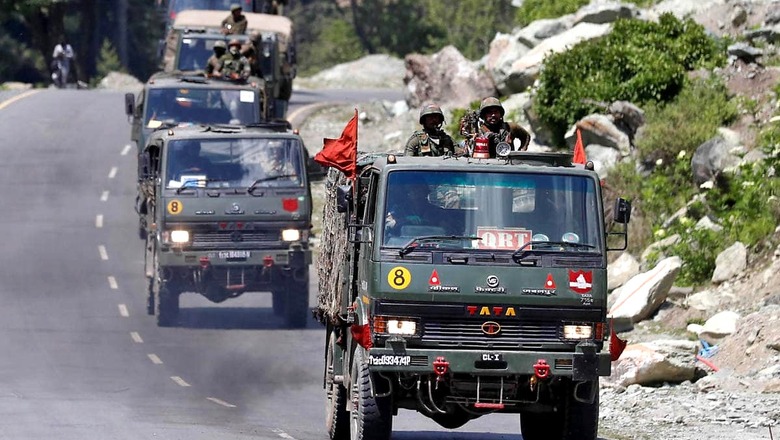
views
Much before defence minister Rajnath Singh made a statement in the Rajya Sabha on February 11 about the pullback of Indian and Chinese troops from the Pangong lake area, news to the effect and video clips of tanks moving back were already in the media. Wu Qian, senior colonel from China’s ministry of national defence, had issued a statement saying, “The Chinese and Indian frontline troops at the southern and northern bank of the Pangong Tso start synchronised and organised disengagement from February 10.” Ground-level commanders from both sides held a meeting over the pullback on February 9 to tie up details of on-ground disengagement and another meeting between them was held on February 10 to streamline the disengagement process.
Rajnath Singh told Rajya Sabha that India and China have agreed to disengage from the Pangong Tso area and both sides will cease their forward deployments in a phased, coordinated and verified manner. He talked of China amassing a large number of troops and armament since April-May 2020 “adjacent” to Eastern Ladakh and making several attempts to transgress (pseudonym for intrusions) the LAC in various parts and that these actions were detected and appropriately responded to by our armed forces (we could have captured Galwan Heights on the night of June 15-16, 2020, if the political hierarchy had shown some guts). Rajnath Singh then spoke of continued communications with China at various levels since September 2020 in order to effect disengagement and maintain status quo along the LAC for restoring peace and tranquility.
He acknowledged that Chinese actions since last year have seriously disturbed peace and tranquility and spoke of several friction areas, with China having mobilised a large number of troops and armaments “along the LAC” as well as in the depth areas. He said many strategically important points were identified in Pangong Tso area and our troops positioned themselves at those hill tops and at locations which were very important from our point of view and because of this and the bravery of our armed forces we maintained the edge.
Rajnath informed the Rajya Sabha that the disengagement agreed to in the North and South Bank of the Pangong lake includes: both sides to cease their forward deployments in a phased, coordinated and verified manner; Chinese troop presence in the North Bank to continue east of Finger 8; Indian troops to be at Dhan Singh Thapa Post near Finger 3; similar action to be taken in the South Bank by both sides; structures built by both sides since April 2020 on both banks to be removed and landforms restored; temporary moratorium on military activities by both sides in the North Bank including patrolling; patrolling to be resumed only when both sides reach a subsequent agreement, and; implementation of the agreement will substantially restore the situation to that existing prior to commencement of the standoff last year.
Rajnath assured the House that nothing had been conceded in these talks and that both sides have agreed to convene the next meeting of senior commanders within 48 hours after complete disengagement in the Pangong lake area for addressing and resolving all other remaining issues.
In the above context, if disengagement was to be discussed in a phased manner, we should have ensured that Depsang got the top priority given its strategic importance and the fact that the PLA is lodged 20 km deep at the Y-Junction where it had also intruded in 2013 and the issue was discussed then in Parliament.
During the Kargil conflict, India had reduced its deployment in the North Bank of Pangong lake to a post at Finger 4. The PLA built bunkers on the spur, coming down towards this post in recent months, and dug a ditch east of Finger 4 during the current aggression to stop our troops patrolling up to Finger 8 as earlier. Our reversion to a post near Finger 3 or rather between Fingers 2 and 3 reduces our control of the North Bank and narrows down the avenue for going towards Gogra-Hot Springs.
Agreeing to vacate Kailash Range, hilltops covering the Spanggur Gap and heights around Chushul that are dominating PLA’s Moldo Garrison is a strategic blunder for which India may pay dearly in future. We don’t seem to have learned any lessons from the return of the Haji Pir Pass to Pakistan. For China it is a masterstroke, especially without any discussion on disengagement in Depsang and other friction points. These were what gave India an edge, as mentioned by Rajnath Singh. So why give up this edge before discussing overall disengagement?
The proposed moratorium to recommence patrolling may take a few months as it will only be discussed after complete disengagement has been effected. Till then, our troops will not be able to patrol east of Finger 3 in the North Bank of Pangong lake. With the PLA at the Y-Junction in Depsang, the ITBP stopped patrolling to Patrol Point (PP) 10, 11, 11A, 12 and 13 – all of which are short of the LAC. Other friction points include PP14 in Galwan Valley, PP15 in Hot Springs and PP17A in Gogra Post area.
It is unlikely that China will agree to withdraw from Y-Junction in Depsang which gives it a great strategic advantage for further operations towards Daulat Beg Oldi (DBO) and the airstrip in the vicinity, terming it part of its 1959 claim line. China’s long-term strategic aim of joining hands with Pakistan along the Shyok river, capturing the Siachen glacier and reviving the old Silk Route through the Karakoram Pass should not be lost sight of.
As for patrolling, China will insist on buffer zones which will all be in Indian Territory. Indian policymakers should know that even if all this is conceded, which, seeing the trend may well happen, peace with China will remain a chimera given the geopolitical dynamics, despite support expressed by US President Joe Biden. With the kind of new permanent camps being set up proximate to Galwan Heights, Depsang and other locations, concentration and consolidation of PLA troops will continue, ready for the next opportunity.
It is quite evident that China has effectively shifted the LAC westwards and any so-called buffer zones will also be in Indian territory, to the advantage of the PLA. No amount of media management and claiming the Pangong lake disengagement is a “significant breakthrough” can hide this fact. Rajnath Singh’s calls of “not even one inch of territory lost” appear as hollow as his clichés of “kadi ninda” and “ghor ninda” as the home minister in response to Pakistan’s cross-border actions. A cross section is of the view that such coverups are essential for maintaining the morale of own public. But the flip side is that the enemy views us as a ‘soft’ state and takes extra advantage. For that matter, the political norm of terming intrusions as transgressions has become an absurd joke, which needs to be dumped.
Addressing a seminar organised by the Centre for Land Warfare on February 11, Chief of Army Staff General MM Naravane said that while the Indian Army will continue to prepare and adapt to the future challenges, the more proximate, real and present dangers on India’s active borders cannot be ignored. The interesting part is that LAC management has become the forte of the ministry of external affairs in the past few years. Besides, failure to substantially increase our defence budget for financial year 2021-2022 will encourage China to indulge in more mischief.
(The author is a veteran of the Indian Army. Views expressed are personal.)
Read all the Latest News, Breaking News and Coronavirus News here



















Comments
0 comment